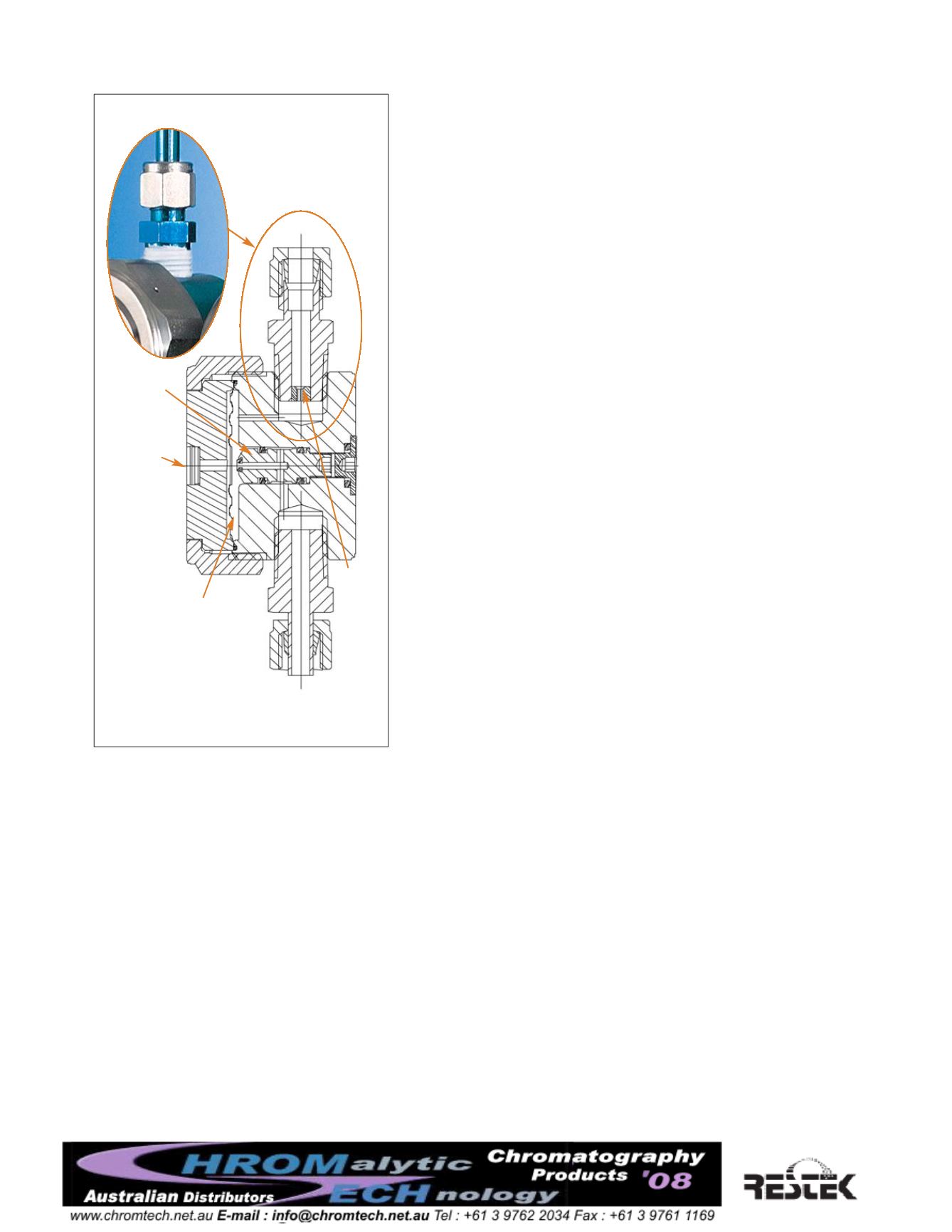
4
The critical orifice determines the flow range. The adjustable piston is used to
set a specific, fixed flow rate within the flow range. An adjustment to the posi-
tion of the piston changes the back pressure, which changes the pressure dif-
ferential across the critical orifice. If the piston is lowered away from the
diaphragm, the flow rate will increase. If the piston is raised toward the
diaphragm, the flow rate will decrease. This flow controller will accurately
maintain a constant flow despite changes in vacuum over a range of 30" Hg to
7" Hg. Flow is constant until the vacuum range of the device is exceeded, mak-
ing the flow controller unable to maintain the constant pressure differential. In
Figure 5, for example, the flow rate is constant from 29.9" Hg to approximate-
ly 7" Hg, at which point the flow rate decreases because the flow controller is
unable to maintain the proper pressure differential. This control will allow the
user to collect approximately 5 liters of sample in a 6-liter canister. This is an
extremely important factor in obtaining valid time-integrated samples
through passive sampling. We will discuss this point further in the Field
Sampling section of this guide.
Vacuum Gauge
A vacuum gauge enables sampling personnel to visually monitor changes in
the vacuum in the canister during sampling. If the flow rate changes unex-
pectedly (e.g., due to a leak or an incorrect setting), the vacuum gauge will
indicate a disproportionately high or low vacuum in the canister, and correc-
tive action can be taken (i.e., flow adjusted) in time to ensure a valid sample.
This type of vacuum gauge is attached to the sampling train, for use in the
field. The vacuum gauge should be of high quality, to ensure that it does not
introduce contaminants into the sample. All wetted parts in the vacuum gauge
shown in Figure 6 (page 7) are constructed of stainless steel; the gauge is accu-
rate to within 1% of full scale.
To monitor pressure in the canister before and after sampling, use a more accu-
rate measuring device. Test gauges built by Ashcroft are accurate to 0.25% of
full scale. These sensitive gauges should not be used in the field - they typical-
ly are wall mounted in the lab. Once used for sampling, a gauge must be
cleaned, and should be certified clean. Procedures are described later in this
guide.
Canister
The canister is a stainless steel vessel designed to hold vacuum to less than 10
mTorr or pressure to 40 psig. Canisters are available in a range of volumes: 850
mL, 1.0 liter, 1.8 liter, 3.0 liter, 6.0 liter, 15 liter, and 35 liter. The size of canis-
ter used usually depends on the concentration of the analytes in the sample,
the sampling time, the flow rate, and the sample volume required for the sam-
pling period (Table 1, page 3). Typically, smaller canisters are used for more
concentrated samples, such as soil gas collection, 3-liter and 6-liter canisters
are used to obtain integrated (TWA) ambient air samples at sampling times of
up to 24 hours, and large 15-liter and 35-liter canisters are used for reference
standards. Sampling time will be limited by the combination of canister size
and the flow rate at which the sample is to be collected.
A well-designed canister is essential to the success of the sampling project.
First, the canister should be made of stainless steel, so the collected sample will
not permeate through the vessel wall or degrade due to exposure to light dur-
ing shipment to the analytical laboratory. Second, the interior surface of the
canister should be inert, to reduce the potential for interactions with the ana-
lytes in the sample. Third, all canisters involved in a particular application
should be of consistent volume, to simplify calculating sample volumes.
Finally, the canister should have a high quality valve that resists abuse in the
field (e.g., overtightening that potentially could cause leaks). An inferior valve
can fail, causing sample loss and incurring replacement costs. It can be more
expensive to sample again than to replace a valve.
Two types of canisters are available, the difference being the interior surface.
The traditional canister is the stainless steel SUMMA® canister. The interior of
Figure 3
Flow controller & critical orifice.
atmospheric
reference
inlet
outlet
critical
orifice
adjustable
piston
diaphragm
Figure 3 courtesy of Veriflo Corp.,
a division of Parker Hannifin Corp.


